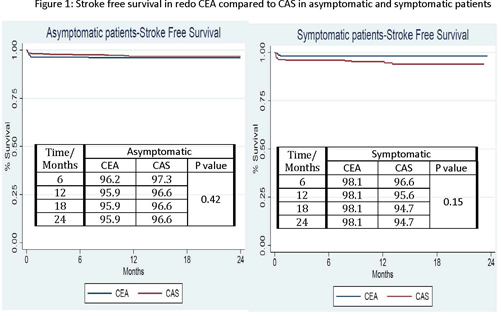Back to 2016 Annual Meeting Program
Redo Carotid Endarterectomy Versus Stenting: Durability and Midterm Outcomes
Isibor Arhuidese1, Tammam Obeid1, Besma Nejim2, Mahmoud Malas2
1Johns Hopkins Medical Institution, Baltimore, MD;2Johns Hopkins Medical Institutions, Baltimore, MD
Introduction: Re-stenotic carotid artery lesions are biologically different from de novo lesions. Although those lesions are less likely to cause a stroke but when they are critical or symptomatic they represent a treatment challenge. Studies in patients with re-stenosis are few and limited by small sample size or inability to align interventions with ipsilateral events and outcomes in the long term. In this study, we perform a population based evaluation of carotid endarterectomy (CEA) vs carotid artery stenting (CAS) outcomes in a large cohort of patients who underwent prior ipsilateral CEA.
Methods: We studied all patients in the Vascular Quality Initiative (VQI) database, who underwent CEA or CAS after prior ipsilateral carotid revascularization between January 2003 and April, 2015. Univariate methods (Chi Square, ttest) were employed to compare patients’ characteristics and outcomes within 30days and in the mid-term. Multivariate logistic and cox regression adjusting for patient characteristics were employed to compare the procedures and identify predictors of ipsilateral stroke, death, myocardial infarction and restenosis. Log-rank and Wilcoxon tests were used to compare survival function between groups.
Results: There were 2863 carotid interventions (CEA: 1047-37%; CAS: 1816-63%) performed in this cohort of patients with prior ipsilateral CEA. The patients who underwent CEA vs CAS had similar age (mean 70 years), gender (female: 42 vs 45%), race (Caucasian: both 95%), symptomatic status (32 vs 34%), prevalence of hypertension (91 vs 93%), diabetes (35 vs 36%), CAD (32 vs 34%), CHF (10 vs 11%) and COPD (29 vs 25%). Perioperative ipsilateral stroke rate comparing CEA vs CAS was 2.2% vs 1.3% (p=0.09) for asymptomatics and 1.2% vs 1.6% (p=0.604) for symptomatic patients. Perioperative mortality and myocardial infarction after CEA vs CAS was 1.3% vs 0.6% (p=0.04) and 1.4% vs 1.1% (p=0.443), respectively. Cranial nerve injury occurred in 2.5% of the redo-CEA cases. CEA was associated with an increased risk of death at 30 days (OR: 2.84, 95%CI: 1.13-7.14, p=0.027) and in the mid-term (HR: 1.97, 95%CI: 1.25-3.12, p=0.004). However, there were no differences in stroke, MI and restenosis between CEA and CAS after adjusting for patient characteristics (Table 1). Stroke free survival was also similar between groups (Figure 1). The significant predictors of stroke or death were: increasing age (OR: 1.06, 95%CI: 1.03-1.09, p<0.001) and CHF (OR: 1.71, 95%CI: 1.02-2.86, p=0.040).
Conclusions: To our knowledge this is the largest study to date to evaluate midterm outcomes of carotid revascularization in patients with prior ipsilateral CEA. Redo carotid endarterectomy is associated with increased mortality and cranial nerve injury compared to CAS. Although, most restenotic lesions are benign, CAS is a safer revascularization approach when the need to intervene arises.
| Unadjusted | Adjusted | |||
| Perioperative | OR (95%CI) | P-value | OR (95%CI) | P-value |
| Stroke | 1.39 (0.77-2.52) | 0.273 | 1.12 (0.50-2.52) | 0.786 |
| MI | 1.30 (0.66-2.55) | 0.444 | 1.37 (0.59-3.21) | 0.464 |
| Death | 2.22 (1.01-4.92) | 0.048 | 2.84 (1.13-7.14) | 0.027 |
| Stroke or death | 1.44 (0.87-2.39) | 0.158 | 1.38 (0.72-2.66) | 0.334 |
| Mid-term | ||||
| Stroke | 0.96 (0.56-1.65) | 0.881 | 1.33 (0.74-2.38) | 0.341 |
| Death | 1.06 (0.79-1.43) | 0.685 | 1.97 (1.25-3.12) | 0.004 |
| Restenosis | 1.30 (0.82-2.06) | 0.259 | 1.78 (0.89-3.54) | 0.102 |

Back to 2016 Annual Meeting Program
